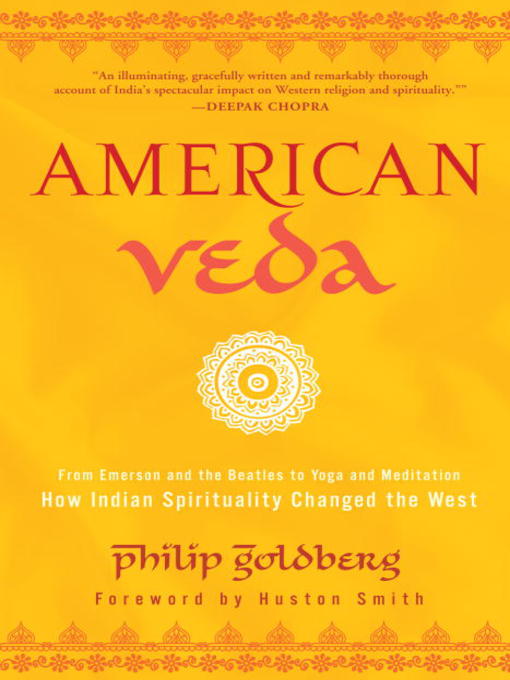
American Veda
From Emerson and the Beatles to Yoga and Meditation How Indian Spirituality Changed the West
کتاب های مرتبط
- اطلاعات
- نقد و بررسی
- دیدگاه کاربران
نقد و بررسی

Starred review from October 18, 2010
Spiritual coach and author Goldberg (Roadsigns) is a knowledgeable and sympathetic chronicler of the past 150 years or so of Indian spiritual ideas' influence on American spirituality. Correctly starting with Emerson and American transcendentalism, Goldberg follows a trail that gets broader, more diverse, and more powerful until yoga is as American as Starbucks, and "spiritual but not religious" becomes a cultural catchphrase describing millions whose notions of the transcendent are more shaped by India's Sanatana Dharma (Eternal Religion) than by Yankee divines and Southern Baptists. Goldberg sorts gurus and systems of yoga, correctly understanding the spiritual aspects of what many Americans think of as a physical fitness discipline. He's on point in tracing the influence of the spiritual philosophy of Vedanta on a legion of influential artists and writers beyond the titular ones—think John Coltrane and the late J.D. Salinger. This book fills a void; scholars have mined the subject of Indian spiritual philosophy, but mostly for the academy, despite the broad impact of Vedantism on popular culture. Goldberg gets it.

October 1, 2010
Of gurus, maharajas, swamis and the other practitioners who have come to American shores bringing "India's leading export"—Hinduism, that is.
Practitioner Goldberg (Roadsigns: On the Spiritual Path—Living at the Heart of Paradox, 2006, etc.), one of many prominent "Hinjus" (Jewish Hindus) who espouse the traditions of South Asia, opens by observing that his book is "about Hinduism," which, narrowly defined, is "a specific set of precepts and practices derived from India's primary religion." Given that Hinduism is the source of Jainism, Sikhism and Buddhism, the other major indigenous faiths of the subcontinent, the concentration on Hinduism as a shortcut for Indian religion seems defensible, though still apt to provoke argument. The author blends scholarly interest with firsthand experience, but his insistence that America is thoroughly Veda-ized—since we all use words like guru, karma, yoga, mantra and maybe even namaste—already seems arguable as well, given the resurgence of fundamentalist Christianity. Still, Goldberg has a point, and he does a capable job of showing the influence Hinduism has had for at least the last century and a half, beginning with the Transcendentalists and winding through the sounds of just about any band that has ever used a sitar. The author also sets his sight on loftier exponents, such as T.S. Eliot, a close student of Sanskrit, and J.D. Salinger, whose texts he reads as Vedanta parables. And then there are the Beats, of course. The organization is a little haphazard and the puns ("Maharishi's little helpers," "the cart before the source," "living the vida veda") may be a little too frequent for some tastes, but Goldberg does yeoman service in chronicling the many ways India has influenced American—and, by extension, Western—culture, often very subtly.
For budding mahatmas, a worthy and vigorous introduction, though less well-written than its closest Buddhist counterpart, Rick Fields's How the Swans Came to the Lake (1981).
(COPYRIGHT (2010) KIRKUS REVIEWS/NIELSEN BUSINESS MEDIA, INC. ALL RIGHTS RESERVED.)

October 15, 2010
Goldberg (founder, Spiritual Wellness & Healing Assocs.) argues that American society has been greatly influenced by Indian philosophy, particularly Vedanta, over the last two centuries, whether we realize it or not. He traces the transmission of Vedanta throughout America's history from such early thinkers as Emerson and Thoreau to popular culture icons to the general public. (He includes such British figures as Aldous Huxley, Christopher Isherwood, and the Beatles but treats them here in their effect on American culture.) Goldberg's writing engages the reader by weaving together the stories of the purveyors of Indian thought in America, yet at times readers may feel they are reading the same chapter over and over with only the cast of characters changing. Not surprisingly, Goldberg focuses mostly on the 1960s and 1970s; only one chapter is devoted to the new millennium. Readers who are seeking a scholarly treatment of this topic will not find it here, as the author himself points out in his introduction. VERDICT This is a good popular treatment of the topic and will appeal to those interested in Eastern spirituality as well as lower-level undergraduates in applicable courses.--Amanda Folk, Univ. of Pittsburgh Lib., Greensburg, PA
Copyright 2010 Library Journal, LLC Used with permission.

Starred review from November 15, 2010
Although Veda is not a household word for many Americans, yoga, guru, and karma are commonplace, and each is rooted in Vedic, or Indian, spirituality, which evolved from the Vedas, the worlds oldest sacred texts. A spiritual counselor and interfaith minister as well as an author, Goldberg delineates the Vedic traditionwhich encompasses Hinduism, Buddhism, Jainism, and Sikhism, and involves meditation and yogathen traces its flowering in the U.S., from its profound impact on Emerson to the Vedic bonfire of the 1960s, the Transcendental Meditation movement of the 1970s, and todays passion for hatha yoga. Because Veda, which translates as knowledge, respects all religious practices, recognizes a transcendent Oneness, and embraces science, it has particular appeal for Americans who identify themselves as spiritual but not religious. In relaxed control of a veritable ocean of material, Goldberg provides lively profiles of influential Vedic gurus, including Krishnamurti, Vivekananda, Paramahansa Yogananda, Maharishi Mahesh Yogi, and B. K. S. Iyengar, and such key followers as the Beatles, Joseph Campbell, Thomas Merton, John Coltrane, J. D. Salinger, Eckhart Tolle, and Deepak Chopra. From meditating movie stars, scandalous gurus, and psychedelic drugs to genuine spiritual breakthroughs and devotion to helping others, Goldbergs history of American Veda takes measure of a powerful, if underappreciated, force.(Reprinted with permission of Booklist, copyright 2010, American Library Association.)

























دیدگاه کاربران